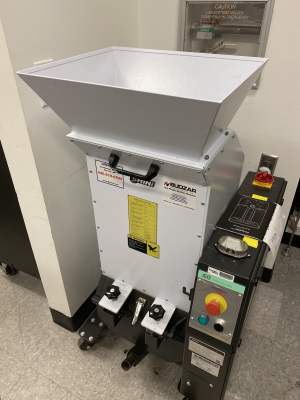Filament Recycling: Difference between revisions
No edit summary |
|||
| Line 20: | Line 20: | ||
==Granulators== | ==Granulators== | ||
[[File:Granulator1.PNG|thumb|A diagram of the internal mechanism of a typical plastic granulator]] | |||
In a plastic granulator, robust cutting knives are mounted in a specific pattern on a open rotor that is spun at high speeds. Stationary knives are mounted within a cutting chamber at precise locations where they are allowed to come in contact with the rotary knives. As the knives come into contact, plastic scrap within the cutting chamber are cut in a scissor-like motion. Granules pass through a screen which limits their maximum size. Granules that fall through the screen are collected for further processing. Granulators reduce materials to much smaller sizes compared to shredders and even grinders, with sizes of 0.2 mm or lower being possible. These small sizes are made possible due to the open-rotor design of granulators that helps to facilitate the processing of lighter materials, compared to the closed-rotor operation of shredders and grinders The open-rotor functionality of granulators also means more air space is present facilitating product agitation and cooling. Granulators tend to require a more specialized feeding process, either by hand, conveyer, or robot, to avoid jamming, in comparison to shredders which do not necessitate as much oversight and can simply be fed material that has been dumped in the feed hopper. | In a plastic granulator, robust cutting knives are mounted in a specific pattern on a open rotor that is spun at high speeds. Stationary knives are mounted within a cutting chamber at precise locations where they are allowed to come in contact with the rotary knives. As the knives come into contact, plastic scrap within the cutting chamber are cut in a scissor-like motion. Granules pass through a screen which limits their maximum size. Granules that fall through the screen are collected for further processing. Granulators reduce materials to much smaller sizes compared to shredders and even grinders, with sizes of 0.2 mm or lower being possible. These small sizes are made possible due to the open-rotor design of granulators that helps to facilitate the processing of lighter materials, compared to the closed-rotor operation of shredders and grinders The open-rotor functionality of granulators also means more air space is present facilitating product agitation and cooling. Granulators tend to require a more specialized feeding process, either by hand, conveyer, or robot, to avoid jamming, in comparison to shredders which do not necessitate as much oversight and can simply be fed material that has been dumped in the feed hopper. | ||
Revision as of 15:29, 15 July 2021
| Shini SG-16N Granulator |
|---|
| Rotor & Knife Type: Solid/Staggered Cut |
| Screen size: 5mm |
| Cutting Chamber: 6.3"x8.3" |
| Bed Knives: 2 |
| Rotating Blades: 9 |
| Thru-put: 76 lbs/hr |
Plastic Granulators and Filament Extruders allow polymers to be recycled for future use in FDM 3-d printers.
Granulators
In a plastic granulator, robust cutting knives are mounted in a specific pattern on a open rotor that is spun at high speeds. Stationary knives are mounted within a cutting chamber at precise locations where they are allowed to come in contact with the rotary knives. As the knives come into contact, plastic scrap within the cutting chamber are cut in a scissor-like motion. Granules pass through a screen which limits their maximum size. Granules that fall through the screen are collected for further processing. Granulators reduce materials to much smaller sizes compared to shredders and even grinders, with sizes of 0.2 mm or lower being possible. These small sizes are made possible due to the open-rotor design of granulators that helps to facilitate the processing of lighter materials, compared to the closed-rotor operation of shredders and grinders The open-rotor functionality of granulators also means more air space is present facilitating product agitation and cooling. Granulators tend to require a more specialized feeding process, either by hand, conveyer, or robot, to avoid jamming, in comparison to shredders which do not necessitate as much oversight and can simply be fed material that has been dumped in the feed hopper.

